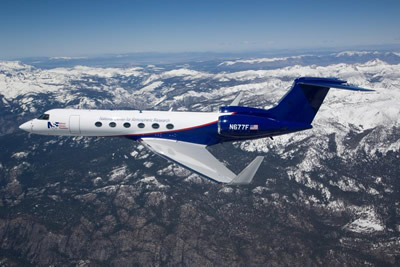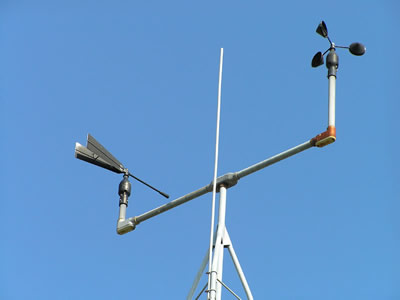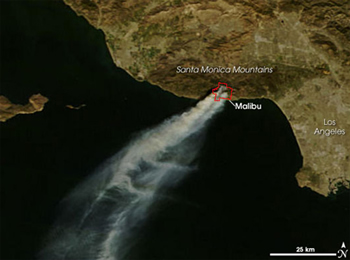This image is from a satellite way up in the sky that takes pictures of the Earth. This picture shows the smoke from a fire over the ocean. The fire was in Southern California and was spread by the Santa Ana winds, a type of foehn wind.
Click on image for full size
Courtesy of MODIS Rapid Response
Related links:
Wind
Weather
Type of Wind: Chinook or Foehn
There are several different types of wind. One type is the foehn wind. This type of wind is found on the eastern side of a mountain and is warm and dry. Some mountainous areas that have this type of wind are the Rocky Mountains and the Alps. In North America, the name for the foehn wind off of the Rocky Mountains is the Chinook wind.
A warm wind like this can help bring relief from cold winter weather. Foehn winds are formed from warmer air being flowing from above. This wind is as strong as some hurricane winds. Foehn winds can melt and evaporate a foot (0.3 meters) of snow in less than a day! These winds can create a fast change in temperature. Temperatures in Granville, ND warmed up by 83º F (28ºC) on February 21, 1918 because of a Chinook wind coming from the Rocky Mountains!
In addition to causing warmer temperatures, foehn winds have other impacts. They can cause snow to melt quickly, leading to avalanches and flash floods. Foehn winds can also create fire hazards. The Santa Ana winds in California are an example of foehn winds. Santa Ana winds have caused brush fires to turn into forest fires. Foehn winds can also dry out the soil so it is hard for farmers to plant crops in the spring.
These winds can be found all over the world where there are mountains and each place has a unique name for them. In Poland, a foehn wind is called halnywiatr. In Romania, this wind is named austru and in Switzerland it is called favogn. Finally, foehn winds in the Andes Mountains are called puelche.
You might also be interested in:

Wind is moving air. Warm air rises, and cool air comes in to take its place. This movement creates the winds around the globe. Winds move at different speeds and have different names based on their speed.
...more
Hurricanes form in the tropics over warm ocean water. The storms die down when they move over land or out of the tropics. At the center of the rotating storm is a small area of calm weather and clear skies
...more
Have you ever left a glass of water out for a long time? Did you notice that the water disappears after a few days? That's because it evaporated! Evaporation is when water passes from a liquid to a gas.
...more
Rainbows appear in the sky when there is bright sunlight and rain. Sunlight is known as visible or white light and is actually a mixture of colors. The sun's rays pass through millions of raindrops. A
...more
It takes the Earth one year to travel around the sun one time. During this year, there are four seasons: summer, autumn, winter, and spring. Each season depends on the amount of sunlight reaching the
...more
Scientists sometimes travel in airplanes that carry weather instruments in order to gather data about the atmosphere. These research aircraft bring air from the outside into the plane so scientists can
...more
An anemometer is a weather instrument used to measure the wind (it can also be called a wind gauge). These instruments can be used in a backyard weather station or on a well-equipped scientific research
...more















